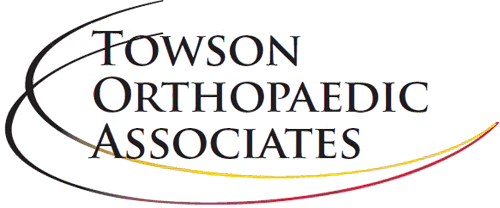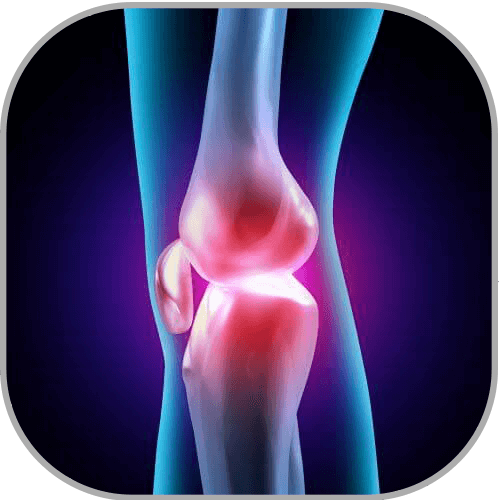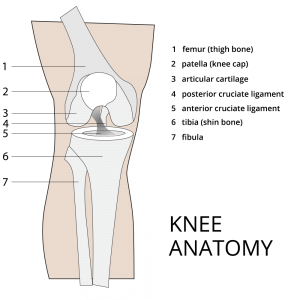One of the most commonly injured knee ligaments, the anterior crucial ligament (ACL) runs diagonally through the knee providing rotational stability and preventing the tibia (shin bone) from shifting in front of the femur (thigh bone). A sprain or tear of the ACL leads to pain, swelling, and a loss of range of motion in the knee.
What is an ACL Tear?
Often caused by rapidly pivoting the knee, direct impact, or landing incorrectly from a jump, ACL injuries are especially prevalent among athletes involved in high demand sports. The severity of an ACL injury ranges from a “Grade 1 Sprain”, in which the ligament has been slightly stretched, to a “Grade 3 Sprain” which involves a complete tear of the ligament. While patients with mild sprains who have very low activity levels (such as the elderly) may sometimes be treated with physical therapy, a torn ACL will not heal without surgery and requires ligament reconstruction or repair to restore stability to the knee.
ACL Injury Treatment
Personalized treatment is essential to the successful outcome of an ACL injury. Our orthopaedic surgeons work closely with each patient to determine the best treatment plan based on factors including age, lifestyle, activity levels, and goals.
ACL Repair
In the past, reconstruction has been the popular form of treatment of an ACL injury—however, in recent years, improved technology has led to growing interest in ACL repair. Years ago, studies were published showing negative results on ACL repairs. Those studies have since been analyzed and determined to be inaccurate for certain types of tears. Data now shows that the success of ACL repair depends highly on the type of injury.
An ACL can tear in one of three places—at the attachment to the femur, the attachment to the tibia, or the center of the ACL itself.
When the ACL tears in the center, the ligament is often left frayed and stretched beyond its normal stress point. In this case, it can be difficult to return the ACL to its normal tension and reconstruction is often necessary.
When the tear occurs at the tibia, a piece of the shin bone often tears away with the ligament. When this occurs, the bone can be reattached without the need for ligament reconstruction. This type of tear is uncommon and usually occurs among pediatric or early adolescent individuals. This procedure is especially valuable in pediatric cases since it reduces the risk of damage to open growth plates.
A tear at the femur can occur in patients of all ages and in most cases involves a clean tear of the ligament which can then be reattached using arthroscopic surgery.
When compared to reconstruction, ACL repair is a much less invasive treatment option and provides a faster and easier rehabilitation. While many centers continue to focus on reconstruction, at the Joint Preservation Center we focus on using the most minimally-invasive procedure available to provide the desired results.
ACL Reconstruction
Utilizing minimally invasive procedures, the torn ligament is replaced with a tissue graft which provides a platform for the growth of the new ligament. A tremendous amount of science is involved in customizing ACL reconstruction to each patient. The position of the graft must be anatomically correct to avoid knee instability and future joint deterioration. Each type of graft has its advantages and disadvantages which should be carefully considered along with the individual needs of the patient.
ACL Graft Options
Patellar Tendon: Most commonly used in ACL reconstruction, patellar tendon grafts deliver successful results and the ability to return to highly competitive sports. While this option provides more strength than others, it also involves a more painful rehabilitation and leaves the front of the knee at risk of future pain (especially when kneeling) and possible development of arthritis in the kneecap (usually 10-15 years later).
Hamstring Tendon: The next most common graft, the hamstring tendon provides benefits similar to the patellar tendon without the risk of future knee pain. However, this option comes with its own set of disadvantages including weakening of the hamstring which can lead to stress on the ACL. In some cases, the patient’s hamstring tendons are too small and require augmentation to provide the necessary amount of strength.
Quad tendon: Like the patellar tendon, the quad tendon provides a thick graft with a good success rate. There is a risk of arthritis and future pain, however, the risk is lower than with the patellar tendon. While this option allows the preservation of the hamstring muscle group and, therefore, the protection of the ACL, some believe there is also an increased risk of stiffness with a quad tendon graft.
Allograft (Cadaver tendon): An allograft is obtained from a cadaver and provides less pain and easier recovery since the graft does not need to be taken from the patient. However, this option is associated with the risk of bacterial infection, failed biologic incorporation, and a longer full-recovery time. Studies have also shown a higher failure rate in young patients when returning to high-demand sports activities.
Reconstruction using an allograft can be more costly than other options since the tissue must be purchased. It’s extremely important for the tissue to come from a reputable tissue bank to reduce the risk of infection. Additionally, exposure to high doses of radiation can compromise the structure of the allograft making it susceptible to poor biologic incorporation or re-tearing. At TOA Joint Preservation Center, our physicians choose tissue banks very carefully to ensure the highest quality tissue for our patients.
After Surgery: ACL Injury Rehabilitation
As with any surgical procedure, rehabilitation plays a vital role in recovery following ACL surgery. Your doctor will discuss pain management options with you and an individualized physical therapy regimen will begin immediately to help you regain full range of motion as quickly as possible.





